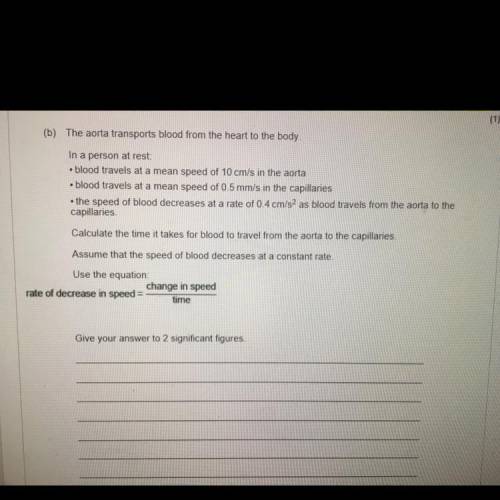The aorta transports blood from the heart to the body.
In a person at rest:
• blood tr...

Biology, 22.12.2021 14:20 serenityburke
The aorta transports blood from the heart to the body.
In a person at rest:
• blood travels at a mean speed of 10 cm/s in the aorta
• blood travels at a mean speed of 0.5 mm/s in the capillaries
• the speed of blood decreases at a rate of 0.4 cm/s2 as blood travels from the aorta to the
capillaries
Calculate the time it takes for blood to travel from the aorta to the capillaries.
Assume that the speed of blood decreases at a constant rate.
Use the equation:
change in speed
rate of decrease in speed = change in speed / time


Answers: 3


Another question on Biology

Biology, 21.06.2019 22:30
How do tides affect the organisms living in intertidal zones? a. no organisms live in intertidal zones due to the tumultuous environment. b. the mechanical forces of the waves keeps the organisms clean. c. only plants live in intertidal zones because the animals float away with the waves and never return. d. the mechanical forces of the waves can dislodge the organisms from their habitat.
Answers: 2

Biology, 22.06.2019 02:00
The finches on the galapagos island were similar in form except for variations of their beaks. darwin observed that these variations were useful for: attracting a mate defending territory building nests gathering food
Answers: 3

Biology, 22.06.2019 04:30
What is the correct term for an area of rotating currents in an ocean? when ocean currents combine, they create an area of rotating currents called an
Answers: 2

Biology, 22.06.2019 04:30
The green colored pigment in chloroplasts is? a. nitrogen b. chlorophyll c. chlorophorm d. chlorofloromethane
Answers: 2
You know the right answer?
Questions

Business, 02.03.2020 05:05

Mathematics, 02.03.2020 05:05

Chemistry, 02.03.2020 05:05



Mathematics, 02.03.2020 05:05

Spanish, 02.03.2020 05:06


English, 02.03.2020 05:06





Mathematics, 02.03.2020 05:06



Biology, 02.03.2020 05:07

Biology, 02.03.2020 05:07


Mathematics, 02.03.2020 05:07



